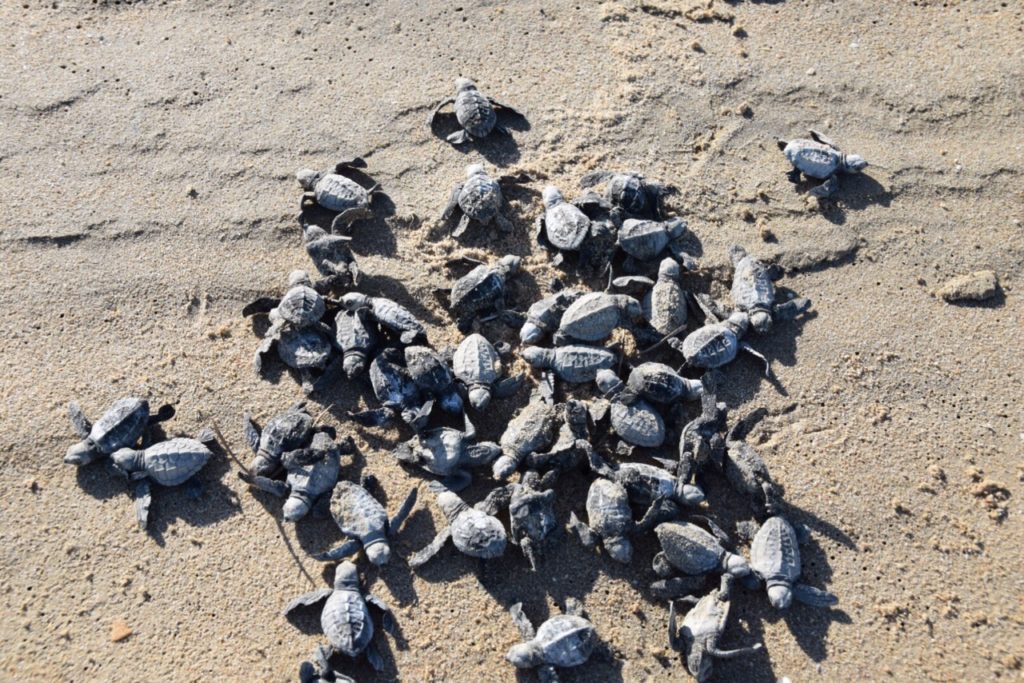
Hatchlings scramble for the sea (Image: APN Cape York)
Did you catch our science this summer? As we say hello to autumn, here’s our fab February quiz. We take a look back and celebrate another month of exciting and interesting science stories.
Results
#1. We recently did a virtual tour of our Australian National Insect Collection. How many insect specimens do we store in the collection?
Our collection is home to more than 12 million specimens stored inside more than 22,000 drawers. It’s the largest collection of Australian insects on the planet.
#2. New research has shown global emissions of CFC-11 are in decline. How much did they decline from 2018 to 2019?
The significant drop of about 25 to 30 percent have returned us to pre-2013 emissions levels. Tracking the rise and fall of these damaging ozone-depleting and greenhouse gases is possible thanks to the global network of atmospheric monitoring stations. This includes our Australian Cape Grim Baseline Air Pollution Monitoring Station.
#3. We recently received a licence to develop medicinal cannabis. Where is our state-of-the-art Botanical Extracts Lab for developing cannabis-derived products?
Our Botanical Extracts Lab is in Melbourne is where we’ll focus our development on a range of cannabis-derived products. We’ll investigate extraction, purification, and formulation techniques. They’ll offer new medical products on top of the oils, capsules, sprays, and lozenges already available.
#4. We’re building a new hydrogen refuelling station at our Clayton hub in Victoria. How do emissions produced by hydrogen-powered cars compare with conventional cars?
That’s right, hydrogen-powered cars have zero emissions. Through the nature of hydrogen and the way it is processed a hydrogen-powered car will only omit water vapour and warm air.
#5. Canine ehrlichiosis is a tick-borne dog disease recently detected in parts of Australia. It has some nasty symptoms for our four-legged friends. What are they?
Sadly, the disease has many painful effects on dogs as you can see above. While we are working to better understand and treat the disease, prevention can be useful in preventing and spreading it further. It’s always important to talk to your vet about tick prevention and control options. If you live in or visit a tick-infested area, you should do a daily inspection of your dogs for ticks and familiarise yourself with the best way to remove them.
#6. Three nations have launched ambitious missions to the red planet of Mars! Which countries?
China, the United Arab Emirates (UAE) and the USA have all launched missions to Mars around the same time. While the three nations all have different missions on Mars, they will be supported by our Canberra Deep Space Communication Complex (CDSCC), which helps with communication between Mars and Earth.
#7. Our research led to a grim estimation of the number of albatross deaths caused by plastic ingestion. Which percentage?
That’s right, we estimate that up to 17.5% of near-shore albatross deaths in the southern hemisphere are caused by plastic ingestion. This should be considered a substantial threat to albatross populations. Plastic drink bottles, disposable utensils and balloons are among the deadliest items.
#8. Our researchers are working with Indigenous rangers in Cape York, Microsoft and the Australian Government, to protect baby turtles. Which predator is very troublesome for baby turtles?
Feral pigs are the biggest and most prevalent danger to baby turtles in Cape York. To protect the turtles, rangers need to understand – almost in real-time – where turtles are laying their eggs, where the pigs are eating the nests, and when. If rangers can get fast access to this information (monitoring data) in the first few days, they can quickly decide where they will focus their pig-control efforts.
#9. Using our ASKAP telescope, how many twinkling galaxies did we discover in a rare alignment?
Thanks to the discovery of five twinkling galaxies in a rare alignment, astronomers have been able to calculate the properties and geometry of an invisible gas cloud in space.
#10. Our researchers are looking for SARS-CoV-2 in wastewater. How soon can infected people shed the virus in their faeces before showing symptoms?
Infected people shed the virus in their faeces about three to five days before showing symptoms. Getting an early signal of infections in an area helps health authorities act early on local measures to limit infection spread.
How did you go in the quiz? Did you fly through or flop? Let us know in the comments below.





4th March 2021 at 4:39 am
Best on Instagram
4th March 2021 at 3:53 am
6/10 – not terrible for a woman embarrassingly out of the loop! I will certainly be paying more attention to science news from now on, and where better than from one of the most trusted scienticfic organisations in the world?!
Thank you for all that you do CSIRO.
3rd March 2021 at 8:38 pm
8 was ok .yes I do like receiving your news letters I’m 69 I just wished I could have had this information at a younger age. Your team is doing a TOP JOB .Thanking you Allan
3rd March 2021 at 10:34 pm
Thanks for your kind words Allan! They’re much appreciated.
Kind regards,
Team CSIRO